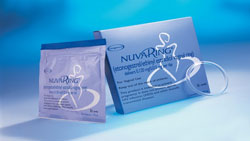In direct result of the recent NuvaRing lawsuits, the poten¬tial side effects of available hormone-based contraceptives have been questioned.
There are currently more than 1,000 pending lawsuits against the NuvaRing manu¬facturer Merck & Co. for their failure to properly warn the public about the severity of the contraceptive’s side effects, ac-cording to a recent Vanity Fair article released in Janurary.
NuvaRing, which is a ring in¬serted into the vagina, is a form of birth control that releases hormones intended to prevent ovulation and pregnancy.
In the Vanity Fair article, the scientific reports of the hormones used in the NuvaR¬ing found that the hormone desogestrel was used during manufacturing.
Vanity Fair stated that desogestrel is a third-genera¬tion progestin that was first used in contraceptives during the early 1990s, and is still used in many contraceptives today. The hormone was first used in contra¬ceptives, as opposed to its other hormone counterparts, for its lessened side effects of hair loss and acne.
Despite the fact that some side effects were lessened, other side effects became drastically se¬vere. The Vanity Fair article ex¬plained that several of the court documents filed in the lawsuit against Merck & Co. reported that since the mid-1990s, a little over 10 scientific studies about third-generation hormones used in contraceptives, like desoges¬trel, determined that the hor¬mones were twice as likely to cause blood clots as opposed to birth control methods that used one-generation or two-genera¬tion hormones.
A study done by the Federal Drug Administration (FDA) in 2011, found similar results and reported that vaginal rings could increase the risk of blood clots in women by about 56 percent. Furthermore, a 2012 study by the British Medical Journal found a 90 percent greater risk for ve¬nous thromboembolisms to occur from birth-control pills with ear¬lier generation hormones.
While hormones similar to desogestrel have mostly been studied in birth-control pills and vaginal rings, according to plannedparenthood.org the hor¬mones could also be found in oth¬er contraceptive devices such as the patch (known as Ortho Evra), birth control implants, birth con¬trol shots, as well as several other birth control options.
Lisa Sypniewski, a senior health studies major, said that she knew many people using birth control, but when it came to obtaining her own form of contraceptive she wasn’t very concerned about the side effects. “I was aware that I could experi¬ence some side effects, but I was never too concerned about them. I luckily did not experience any of them, and I did not feel any different when I started to take it. The one that concerned me most was a change in weight, but I did not see any significant impact,” said Sypniewski.
Contrary to Sypniewski’s ex¬perience, Kelly Hughes, a junior communication student, said that her older sister, Marybeth Hughes, experienced concerning side effects from her contracep¬tive, the NuvaRing. Marybeth said, “Immediately after I started NuvaRing I woke up every morn¬ing with tightness in my chest that I literally had to use breath¬ing techniques, like deep breaths and what not, to get it to feel a little better. It happened every day for about two weeks so then I stopped taking it and [started] feeling normal again.”
According to Andrea Hope, an assistant professor for the health and physical education depart¬ment, it is only by chance that certain side effects will be made known to a person. “Several oral contraceptive methods increase the risk of blood clots, especially in women with a history of clots and those who smoke. It is im¬portant to keep in mind that most birth control methods have pros and cons, medical and lifestyle, so women and their partners should consult with their health care provider before choosing one,” said Hope.
Hope continued, and said that, “…many women are not coun¬seled properly about the side ef¬fects, and use the NuvaRing, and other birth control methods with¬out considering or being aware of the risk factors and side effects. [It’s] important for women and their partners to have a good re¬lationship with their health care providers and to educated them¬selves as well.”
Mary Harris, a specialist pro¬fessor for the communication department, did exactly what Hope advised others to do and educated herself on birth con¬trol after a worrying experience she believes was caused by her birth-control, Yazmin. “A cou¬ple of years passed [of me be¬ing on Yazmin] and I was eating clean and everything and I had no symptoms or side effects or anything. I was taking a show¬er one day and I had a really sharp pain in my left arm, from my hand to my shoulder. After the pain went away I just went numb and my hand up to about [my elbow] was like a greenish-blue. I had lost all circulation in my arm and I had small pains in my chest, but that could have been because I was panicking,” said Harris.
Harris continued to explain that after the incident she went to the emergency room and told them that she was on Yazmin and knew that it caused blood clots, although the doctors could not find anything. Shortly after, Har¬ris made the decision, without her doctor’s approval, to get off of the contraceptive and find a holistic doctor to help her with¬out the use of medications or brand name drugs.
Following her decision to quit the pill, Harris said that she ex¬perienced “awful things” happen to her body. “It’s almost like my body needed to be on it because I’ve been feeding it a synthetic, fake hormone,” said Harris, ” It felt like I was chronically crawl¬ing out of my skin…it takes a long time to get seven years of synthetic hormone out of your system.”
Harris said that she doesn’t recommend these contracep¬tives at all to anyone. “I know that I was on a medication for seven years and it damaged my body and I saw a slew of side effects that can go unnamed, but the point is that I wish I had known, really known. And I didn’t.”
IMAGE TAKEN from drugdangers.com



